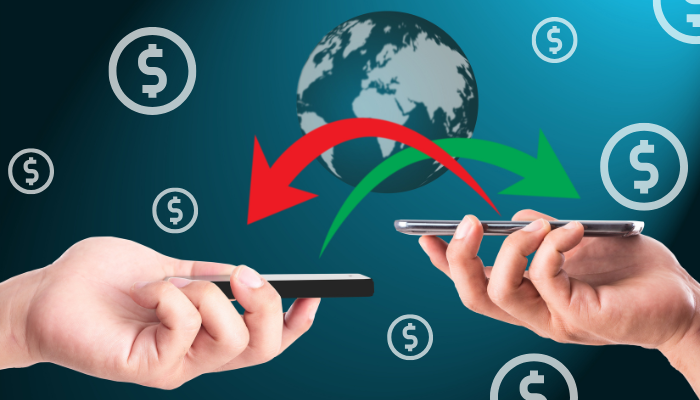From splitting the bill at a restaurant to sending a birthday gift, P2P payment apps like Venmo have become integral to our daily lives. Their convenience is undeniable.
But what goes into creating an app like Venmo?
This blog post takes you on a journey through the steps of how to build a p2p payment app, examining the key features and cost factors along the way. Whether you’re aiming to build the next Venmo or a niche payment solution, this guide will provide valuable insights.
What is a P2P Payment App?
Simply put, a peer-to-peer (P2P) payment app lets individuals send and receive money electronically, usually through their smartphones. It’s like handing cash to a friend, but digitally. These apps cut out the middleman (like banks and traditional payment processors), offering a faster, more convenient way to transfer funds. No more checks, money orders, or trips to the ATM.
No more checks, money orders, or trips to the ATM. This ease of use is a big reason why P2P payment apps have exploded in popularity. But just how big is this trend?
Let’s take a look at the global momentum behind P2P payments.
P2P Payment App Market Size
P2P payments are booming worldwide. More and more people are ditching cash and checks in favor of quick, digital transactions on their phones. This growth isn’t just a fad; it’s a fundamental shift in how we handle money.
- The global mobile payment market size to reach USD 10,477.0 Billion by 2033,
- By 2025, the user base for mobile payments worldwide is estimated to be 3.8 billion.
These numbers paint a clear picture: P2P payments are here to stay. So, if you’re thinking about investing in a P2P app, you’re entering a growing market.
But before you dive in, it’s essential to understand the different types of P2P applications out there.
Types of P2P Applications to Consider
Not all P2P apps are created equal. They vary in functionality, target audience, and features. Understanding these differences is crucial for choosing the right approach for your business. Here are a few key types to consider:
- Standalone P2P Apps: These apps, like Venmo and Cash App, operate independently of traditional banking systems. They often offer features like social feeds and splitting bills, appealing to a younger demographic.
- Bank-Centric P2P Apps: Many banks offer their own P2P payment services integrated into their existing mobile banking apps. Zelle is a prime example, connecting directly to users’ bank accounts for seamless transfers.
- Social Media Integrated P2P Apps: Some social media platforms, like Facebook Messenger, have integrated P2P functionality, allowing users to send and receive money within their existing social networks.
- International Money Transfer Apps: These apps specialize in sending money across borders, often offering competitive exchange rates and lower fees compared to traditional wire transfers. Examples include Wise (formerly TransferWise) and Remitly.
- Niche P2P Apps: Some P2P apps cater to specific needs or communities. For example, there are apps designed for splitting rent payments, paying contractors, or managing expenses within a small business.
By understanding these different types of P2P applications, you can better define your target audience and choose the features that best align with your business goals.
Now that we’ve explored the landscape, let’s dive into the essential features that every successful P2P payment app needs.
age, and regulatory considerations:
| Feature | Impact | Development Complexity | User Benefit | Competitive Advantage | Regulatory Considerations |
| Secure Transactions | Builds trust, protects user data | High | Peace of mind, secure payments | Yes | PCI DSS, GDPR |
| User-Friendly Interface | Enhances user experience, increases adoption | Medium | Easy navigation, intuitive experience | Yes | Accessibility guidelines |
| Instant Transfers | Provides convenience, speeds up transactions | Medium | Faster payments, immediate access to funds | Yes | Payment processing rules |
| Transaction History | Enables easy tracking of payments, simplifies budgeting | Low | Organized records, better financial control | Yes | Data retention policies |
| Notifications and Alerts | Keeps users informed, enhances transparency | Low | Real-time updates, proactive issue awareness | Yes | Communication preferences |
| Customer Support | Resolves issues quickly, builds user confidence | Medium | Quick assistance, problem resolution | Yes | Service level agreements |
| Integration with Other Apps | Expands functionality, streamlines financial management | Medium | Connected experience, enhanced functionality | Yes | Data sharing agreements |
| Two-Factor Authentication (2FA) | Adds an extra layer of security, protects user accounts | Medium | Enhanced security, account protection | Yes | Security best practices |
| Biometric Authentication | Offers convenient and secure login options | Medium | Easy and secure login | Yes | Privacy regulations |
| Spending Limits/Budgeting Tools | Helps users manage their finances | Medium | Better financial control, spending awareness | Yes | – |
We’re pretty proud of this one. Check out our P2P lending platform case study and see what we can do.
How To Build A P2p Payment App: A Step-By-Step Guide
Developing a P2P payment app is a complex undertaking, but by breaking it down into manageable steps, the process becomes much clearer. This guide outlines the essential stages of development, from initial concept to final launch.
Now, let’s outline those steps
Idea Validation and Market Research:
This crucial first step confirms whether your app idea has potential. Don’t skip it!
- Identify Your Target Audience: Who are you building this app for? Students? Freelancers? Small business owners? Understanding your target audience is fundamental.
- Analyze Competitors: What other P2P payment apps are out there? What are their strengths and weaknesses? Identify opportunities to differentiate your app.
- Conduct Surveys and Interviews: Gather feedback directly from your target audience. Ask about their payment habits, pain points, and desired features.
- Analyze Market Trends: Research the current and future trends in the P2P payments space. Is there a growing demand for specific features or functionalities?
2. Define Core Features and Functionality:
Now that you’ve validated your idea, it’s time to define the core features of your app.
- Prioritize Must-Have Features: Focus on the essential functionalities that will address your target audience’s needs. Refer back to the table of must-have features we created earlier.
- Consider Unique Selling Propositions (USPs): What will set your app apart from the competition? Perhaps a unique reward system, integration with a specific platform, or a niche focus.
- Create User Stories: Develop user stories to outline how users will interact with your app. This helps ensure a user-centered design approach.
3. Compliance and Security Considerations:
Security and compliance are non-negotiable in the financial world.
- Research Relevant Regulations: Familiarize yourself with KYC/AML regulations, data privacy laws (like GDPR), and payment processing standards (like PCI DSS).
- Implement Robust Security Measures: Employ encryption, fraud detection systems, and secure authentication methods to protect user data and transactions.
- Consult with Legal Experts: Seek professional legal advice to ensure full compliance with all applicable regulations.
9. Cost of Development:
Developing a P2P payment app requires a significant investment. The actual cost will vary depending on several factors, including:
- App Complexity: A feature-rich app with advanced functionalities will naturally cost more to develop than a simpler application.
- Platform: Developing for multiple platforms (iOS, Android) increases development time and cost.
- Development Team: The size and experience of your development team will impact the overall cost.
- Location: Development costs can vary significantly based on the location of your development team.
It’s essential to create a realistic budget and explore different development options, such as outsourcing or hiring an in-house team.
10. Legal and Regulatory Considerations:
Navigating the legal and regulatory landscape is crucial for any financial application.
- KYC/AML Compliance: Implement Know Your Customer (KYC) and Anti-Money Laundering (AML) procedures to verify user identities and prevent financial crimes.
- Data Privacy: Comply with data privacy regulations like GDPR and CCPA to protect user data and ensure transparency.
- Payment Processing Regulations: Adhere to payment processing regulations and standards, such as PCI DSS, to ensure secure transactions.
- Legal Counsel: Consult with legal experts specializing in fintech and financial regulations to ensure full compliance.
11. Monetization Strategies:
How will your P2P payment app generate revenue? Consider various monetization models:
Transaction Fees:
This is a common approach where you charge a small fee for each transaction processed through your app.
- Pros: Directly tied to usage, potentially generating significant revenue as transaction volume grows. Easy to implement with existing payment gateways.
- Cons: Can deter users if fees are too high, especially in a competitive market. Requires careful balancing to avoid impacting user adoption.
- Considerations: Offer competitive transaction fees, potentially tiered based on transaction amount or user type. Provide transparent fee information to users.
2. Subscription Model:
Offer premium features or services for a recurring subscription fee.
- Pros: Creates a recurring revenue stream and can incentivize users to upgrade for enhanced functionality.
- Cons: Requires developing compelling premium features that justify the subscription cost. May limit accessibility for some users.
- Considerations: Offer a free tier with basic functionality and a premium tier with advanced features like enhanced security, priority support, or advanced analytics.
3. Advertising:
Display targeted ads within the app.
- Pros: Can generate significant revenue, especially with a large user base. Allows for a free-to-use model for basic functionality.
- Cons: Can negatively impact user experience if ads are intrusive or irrelevant. Requires careful implementation to avoid alienating users.
- Considerations: Focus on non-intrusive ad formats, such as native ads or sponsored content. Target ads based on user demographics and interests to ensure relevance.
4. Partnerships:
Collaborate with businesses to offer exclusive deals and promotions within the app.
- Pros: Can generate revenue through affiliate marketing or co-branded promotions. Provides added value to users through exclusive offers.
- Cons: Requires establishing and managing partnerships. Success depends on finding relevant and valuable partners.
- Considerations: Partner with businesses that align with your target audience and offer products or services that complement your app’s functionality. Ensure transparency with users regarding sponsored content or promotions.
Understanding the financial commitment involved in building a P2P payment app is crucial for planning and budgeting. Let’s break down the cost and time investment you can expect.
Cost and Time Investment for P2P Payment Apps
Several factors influence the overall cost and timeline of your project. The table below provides a general overview, but remember that these are estimates and can vary significantly based on your specific requirements.
| Factor | Description | Impact on Cost & Time |
| App Complexity | The number and complexity of features, such as user authentication, transaction processing, security measures, and third-party integrations, directly impact the development effort. | Significant |
| Required Integrations | Integrating with payment gateways, banks, and other third-party services adds complexity and requires additional development time. | Moderate to High |
| Development Stages | Each stage, from planning and design to development, testing, and launch, has associated costs. | Varies per stage |
| Planning & Design | This phase involves market research, defining features, and creating the app’s design. | Low to Moderate |
| Development | The actual coding and development of the app’s functionalities. | Significant |
| Testing | Thorough testing is crucial and can take a considerable amount of time, especially for complex applications. | Moderate to High |
| Deployment & Launch | Launching the app on app stores and setting up the necessary infrastructure. | Low to Moderate |
| Team Size and Location | A larger team can potentially speed up development, but also increases costs. The location of your development team significantly impacts hourly rates and overall expenses. | Significant |
| Post-Launch Maintenance | Ongoing maintenance, bug fixes, and updates are essential and require ongoing resources. | Ongoing, Low to Moderate |
Ready to build your P2P payment app? Don’t go it alone. Choosing the right development partner is crucial for success. Choosing the wrong P2P app development partner can derail your project. Missed deadlines, cost overruns, and security vulnerabilities are just a few of the potential consequences. Don’t let your vision fall short.
- Compliance Headaches: P2P payment apps operate in a heavily regulated environment. A partner lacking expertise in KYC/AML regulations, data privacy laws (like GDPR), and payment processing standards (like PCI DSS) can expose your business to legal issues, hefty fines, and reputational damage. Ensuring compliance from the outset is crucial.
- Damaged Reputation: A poorly performing app riddled with bugs, security flaws, or a confusing user interface can severely damage your brand’s reputation. Negative reviews and frustrated users can quickly erode trust and make it difficult to attract new customers. First impressions matter, especially in the competitive world of fintech.
- Lost Revenue: A subpar app that fails to meet user expectations will struggle to gain traction. Low adoption rates, high churn, and negative word-of-mouth can significantly impact your revenue potential. Investing in a high-quality app from the start is a much wiser financial decision in the long run.
- Wasted Time and Money: Perhaps the most painful consequence of choosing the wrong partner is the wasted time and money. Missed deadlines, unexpected costs, and the need to rework poorly executed features can quickly drain your resources and set your project back significantly. Choosing a reliable and experienced partner from the outset is the best way to protect your investment.
Codewave: Your Partner in Building Seamless P2P Payment Solutions
Tired of generic promises and cookie-cutter approaches? At Codewave, we understand that every P2P payment app is unique. We offer customized solutions designed to meet your specific business needs and bring your vision to life.
Our P2P App Development Services:
- Custom P2P App Development: From concept to launch, we build bespoke P2P applications tailored to your exact requirements.
- Seamless Payment Gateway Integration: We integrate with leading payment gateways, ensuring secure and reliable transactions.
- Robust Security and Compliance: We prioritize security at every stage, adhering to industry best practices and regulatory requirements.
- User-Centric UI/UX Design: We create intuitive and engaging user interfaces that enhance the payment experience.
- Scalable Architecture for Growth: We build apps that can handle increasing transaction volumes and user growth.
- Blockchain Integration: We can integrate blockchain technology for enhanced security and transparency.
- Ongoing Maintenance and Support: We provide ongoing support and maintenance to ensure your app remains competitive.
Ready to build the next Venmo? (Or something even better?) Get in touch!
Codewave is a UX first design thinking & digital transformation services company, designing & engineering innovative mobile apps, cloud, & edge solutions.







